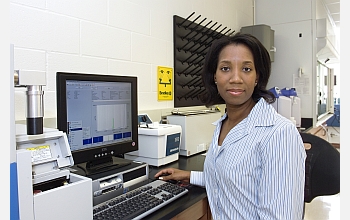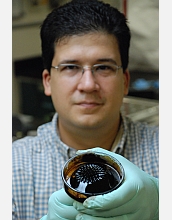All Images


Press Release 07-164
Beginning Scientists Receive Presidential Awards

Twenty NSF nominees receive the government's highest honor for scientists and engineers beginning their independent careers
Back to article | Note about images
 |
Winners of the 2006 Presidential Early Career Awards for Scientists and Engineers were honored at the White House on Nov. 1, 2007. In addition to the 20 winners nominated by the National Science Foundation, 38 winners were nominated by other federal agencies.
Credit: Teddy Yoshida |
Download the high-resolution JPG version of the image. (766 KB)
|
Use your mouse to right-click (or Ctrl-click on a Mac) the link above and choose the option that will save the file or target to your computer.
|
 |
 View video View video
At an NSF ceremony in their honor, several PECASE winners discuss the scientific work leading to this recognition.
Credit: National Science Foundation
|
 |
In addition to her work as a geneticist, Ahna Skop is an artist inspired by the images of biology, including dividing cells. She runs an art exhibit at an annual international conference of the Genetic Society.
Credit: University Press, University of Wisconsin-Madison |
Download the high-resolution JPG version of the image. (37 KB)
|
Use your mouse to right-click (or Ctrl-click on a Mac) the link above and choose the option that will save the file or target to your computer.
|
 |
Mechanical engineer Jim Schmiedeler is using a robotic system to develop a mathematical model of motor coordination. Based on that model, Schmiedeler will collaborate with the university's divsion of physical therapy and department of physical medicine and rehabilitation to develop a robot to aid patients' physical rehabilitation. Over time, the device would help physical therapists gauge a patient's improvement.
Credit: Ohio State University |
Download the high-resolution JPG version of the image. (1.2 MB)
|
Use your mouse to right-click (or Ctrl-click on a Mac) the link above and choose the option that will save the file or target to your computer.
|
 |
Chekesha Liddell's work in materials science and engineering centers on how tiny non-spherical particles can be induced to arrange themselves into structures that promise a significantly higher level of control over light waves than traditional optical materials.
Credit: Chekesha Liddell, Cornell University |
Download the high-resolution JPG version of the image. (2.4 MB)
|
Use your mouse to right-click (or Ctrl-click on a Mac) the link above and choose the option that will save the file or target to your computer.
|
 |
Geophysicist Matt Fouch is shown working with a digital broadband seismometer installed in northern Nevada. This seismic station is part of a 100-plus station seismic array deployed as one component of an NSF-funded multidisciplinary geological and geophysical project to understand the tectonomagmatic evolution of the High Lava Plains and surrounding regions in the northwestern United States. The seismometer (ground motion sensor) is in a plastic drum beneath the pile of dirt in the foreground; the seismograph (data recorder) and power system is in the box in front of Fouch; and there is a solar panel (for power) and a GPS receiver (for high-accuracy timing) behind him. The system is contained within a barbed-wire fence to protect it from cattle which occasionally graze in the region.
Credit: Matt Fouch, School of Earth and Space Exploration, Arizona State University |
Download the high-resolution JPG version of the image. (977 KB)
|
Use your mouse to right-click (or Ctrl-click on a Mac) the link above and choose the option that will save the file or target to your computer.
|
 |
Chemical engineer Carlos Rinaldi holds a beaker with oil based ferrofluid (a suspension of magnetic nanoparticles in an oil carrier fluid) with a permanent magnet underneath. The ferrofluid displays the so-called normal field instability, characterized by spikes of fluid following the local magnetic field direction. Rinaldi's work has importance for applications in nanobiosensors and in magnetic fluid hyperthermia for cancer treatment.
Credit: Sindia M. Rivera-Jiménez |
Download the high-resolution JPG version of the image. (2.7 MB)
|
Use your mouse to right-click (or Ctrl-click on a Mac) the link above and choose the option that will save the file or target to your computer.
|
|








